The week at a glance
- Rock Bunting photographed in North Yorkshire
- Audouin's Gull in Suffolk
- Calandra Lark in Lincolnshire
- Collared Flycatcher on Fair Isle and in Norfolk
- Rufous-tailed Rock Thrush reported on Scilly
- Long-staying Oriental Turtle Dove and House Crow still present
The week saw a startling find and a run of one-day quality rarities, frustrating many who couldn't drop everything and jump in the car.
The most incredible record of the week was of a male Rock Bunting photographed at Bolton Abbey (North Yorkshire) on 8th. This was sent to the BTO, who confirmed and released the news, so it'll be interesting to see how many make the trip to search for this cripplingly rare bird. There are just four previous records, the only ones in recent times a one-day bird on Bardsey Island in 1967 and a long-stayer at Spurn in 1965.

Rock Bunting, Bolton Abbey, North Yorkshire (Photo: Supplied in confidence to BTO)
Second in line was an adult Audouin's Gull at Minsmere (Suffolk) on 9th, present for just four hours before heading off to the beach. There are just six previous records, four of which were also one-day birds, but as the European population increases records will surely become more frequent.

Audouin's Gull, Minsmere RSPB, Suffolk (Photo: Chris Darby)
Equally rare, and equally fleeting, was a Calandra Lark at Gibraltar Point (Lincs) on 11th, which had perhaps also been present the previous evening. This is another island speciality, with 12 of the 15 previous records being off the mainland (or 13 if you include one at Scolt Head in Norfolk), five of them on Shetland. All of the previous mainland records have been one-day birds, so this remains a difficult species to catch up with. Interestingly, there was a record of a Calandra Lark over Texel and Vlieland, Netherlands, on 7th, so perhaps a more accommodating bird might come our way.
Fair Isle's male Collared Flycatcher remained to 5th and remarkably there was then a second record, a bird found at Holme Dunes (Norfolk) on 8th. It had possibly been there all day and overlooked as a Pied Flycatcher, but was found by those looking for a Wood Warbler. Away from the Northern Isles, Norfolk has seen the most records of this eastern gem, with three previous males. The county first was also at Holme, back in May 1969, and coincidentally was found by the father of the co-finder of this most recent bird!

Collared Flycatcher, Holme next the Sea, Norfolk (Photo: Penny Clarke)
One intriguing report was of a Rufous-tailed Rock Thrush on St Agnes (Scilly) on 5th. It was seen by a visiting birder and, with both the resident birders off-island, was never seen again. Elsewhere, the Oriental Turtle Dove remained in Chipping Norton (Oxon) and the House Crow in Cobh (Co Cork).
As might be expected at this time of year, there were no geese of note. Other wildfowl were also in short supply, with seemingly two of each of the rare ducks to choose from. The Ring-necked Duck was at Vane Farm (Perth & Kinross) to 8th and a new drake was at Chew Valley Lake (Somerset) on 6th–9th. The Green-winged Teal remained on North Ronaldsay (Orkney) to 6th and a new bird arrived at Penberry Reservoir (Pembrokeshire) on 6th–7th. The two Lesser Scaup remained, at Martin Mere (Lancs) and Slimbridge (Glos).
Scotland continued to hold the best of the sea-ducks: a Surf Scoter was at Drumbeg (Highland) on 7th, the King Eider remained on the Ythan estuary to at least 7th, and a drake Northern Eider was at Garths Ness (Shetland) on 8th, with a possible off Ardivachar Point, South Uist (Outer Hebrides) on 11th. Similarly, both of the week's White-billed Divers were north of the border, singletons off Port Nis, Lewis (Outer Hebrides) on 5th and Burghead (Moray & Nairn) to 9th.
The spring run of records of Glossy Ibis continued, with a long-overdue first for Leicestershire & Rutland at Rutland Water on 5th. One briefly at Lea Farm GP (Berks) on 7th was presumably the same bird as at Dorney Lake (Bucks) on 7th–8th. This was the second record for Buckinghamshire but, considering the first was back in 1886, this was a welcome bird for many county listers. There was then a further record from Stoke Ferry (Norfolk) on 10th, which again might be the same bird moving on. There was just one report of Sacred Ibis this week, at Congleton (Cheshire) on 11th.
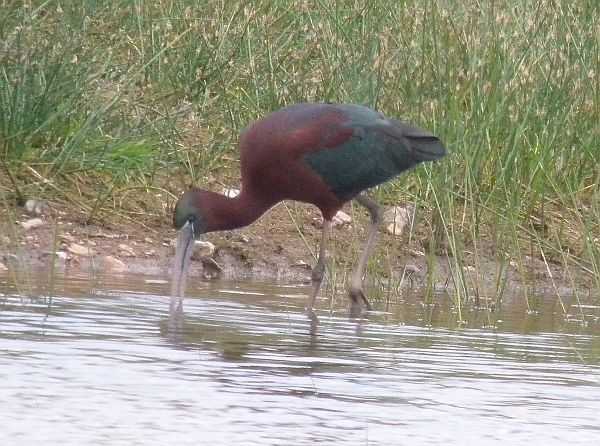
Glossy Ibis, Dorney Lake, Buckinghamshire (Photo: Jim Rose)

Sacred Ibis, Congleton, Cheshire (Photo: Mike Atkinson)
Two Purple Herons remained on Denge Marsh at Dungeness (Kent) to 6th, with others at six sites in the south. Inland birds were at Ogston Reservoir (Derbyshire) for two hours on 8th and another went over Paxton Pits (Cambs) on 10th.

Purple Heron, Ynys-Hir RSPB, Ceredigion (Photo: John A Davis)
Two more new Night Herons were reported this week. The first came from the rather unlikely location of St Kilda (Outer Hebrides), belatedly reported for 4th. The other was a first-summer at Radipole Lake (Dorset) on 8th–9th, the fourth in the county over the last month!
Great White Egrets were rather more numerous this week. Birds were reported from 10 sites as far north as Leighton Moss (Lancs), where one was present on 7th–8th. Also of note were two probables at Hook-with-Warsash (Hants) on 7th. Others were then reported from Cornwall, Dorset, West Sussex, Kent, Suffolk, Norfolk and Cheshire. The only Cattle Egret was also in Dorset, remaining at West Bexington to 6th.
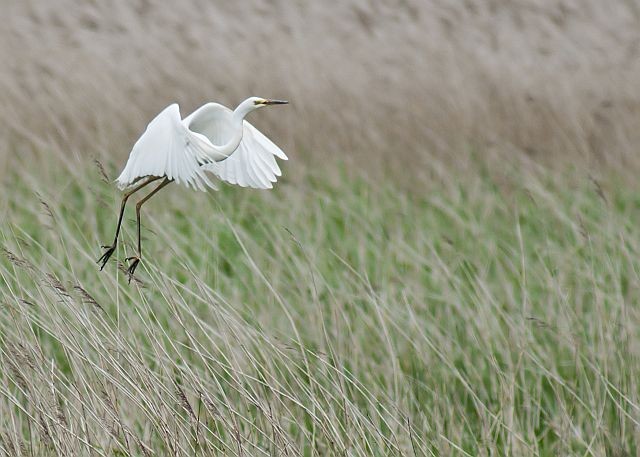
Great White Egret, Marazion, Cornwall (Photo: anon)
Apart from one at Redwick (Gwent) on 5th, all of the week's Spoonbills were in England: birds were spread along the coast at 16 sites, with five at Elmley Marshes (Kent). Of note were birds well inland at Lower Farm GP (Berks) and on Otmoor (Oxon), both on 8th.
Many of April's Black Storks moved quickly through, leaving just one this week, at Brecon (Powys) on 8th, although this was actually a first for the county. Far more numerous were White Storks, although the pattern of occurrences still raises many questions. The cross-country wanderer roamed the Norfolk and Suffolk coast into the weekend, and appeared to head back west on 9th, turning up at Lakenheath Fen (Suffolk) later that evening where it stayed to 11th. There were then two clusters of records: a ringed escapee at Castlerock (Londonderry) on 6th and later at Gweedore (Donegal) on 7th–9th and Bridgend (Donegal) on 11th, and another in Northumberland seen over Long Nanny early morning on 11th and then later at Cresswell Ponds.
The only Rough-legged Buzzards now hanging on were at just a handful of locations across the country. Passage birds were reported over West Runton (Norfolk) on 7th, and the Royal Birkdale Golf Course (Lancs) and Gibraltar Point (Lincs) on 10th. Others lingering at wintering sites included one again reported from Warborough (Oxon) on 10th.
The juvenile White-tailed Eagle got itchy feet (or wings?) again this week and went wandering. It was around several sites in Suffolk and Norfolk on 5th, and was last seen heading over Brancaster (Norfolk) at midday. It was then back in Lincolnshire, seen near Spalding on 8th, but overshot somewhat, being reported from Collingham Pits (Notts) on 9th. It then reoriented, though, and was back at Ruckland (Lincs) by 10th. The only other report was an out-of-range bird at Ovens (Cork) on 8th.
Interestingly, there were further reports of Black Kites from the Northern Isles, with possibly a single bird accounting for sightings on Yell, Unst, Whalsay and Fetlar (Shetland) over 5th–10th. Elsewhere in Scotland, birds were at Prestonpans (Lothian) on 8th, Loch Avich (Argyll) on 7th and Loch of Strathbeg (Aberdeenshire) on 8th–9th. English sightings comprised just two in Suffolk and one in Cornwall.
The flurry of Red-footed Falcon records continued, with Spurn (East Yorks) seeing birds on both 8th and 9th. Also along the east coast were males at Titchwell and Blakeney Point (Norfolk) on 6th and at Flamborough Head (East Yorks) on 11th. Inland birds were males at Tetney Lock (Lincs) on 6th and Paxton Pits (Cambs) on 7th. The only other raptor of note was the white-morph Gyr Falcon remaining at Port Skigersta, Lewis (Outer Hebrides) on 8th. We should probably mention the Eagle Owl snacking on ducklings and Feral Pigeons in Hunstanton (Norfolk) on 8th–10th, but the fact that it looks distinctly more like an Indian Eagle Owl detracts rather from its appeal.
The female Kentish Plover remained at Cockersand Abbey (Lancs) to 5th, and there was a colour-ringed bird in the high-tide roost at Bowness-on-Solway (Cumbria) on 9th, though its origins remain unknown. The American Golden Plover remained on the Hayle estuary (Cornwall) to 7th and there was then a second bird, at Tacumshin (Wexford) on 11th, along with a Buff-breasted Sandpiper. The latter was presumably a return passage migrant and there were further reports of birds in the west. One on Berneray (Outer Hebrides) on 7th–9th was followed by Irish birds at Annagh Head (Mayo) on 9th–11th and Kilcoole (Wicklow) on 11th. This run of passage birds was also reflected in the appearance of several Pectoral Sandpipers, with birds at two sites on Unst (Shetland), one at Pennington Marshes (Hants) on 7th and another on Holy Island (Northumberland) on 9th.

Pectoral Sandpiper, Holy Island, Northumberland (Photo: Colin W. Pears)
Dotterel were again widespread, though once again they were rather northerly in distribution. The furthest south were one at Cleeve Common (Glos) on 5th–7th, one at Garreg Lwyd (Carmarthenshire) on 10th and up to three still on the Long Mynd (Shropshire) to 7th. The peak count was of 12, at Balranald, North Uist (Outer Hebrides) on 7th.
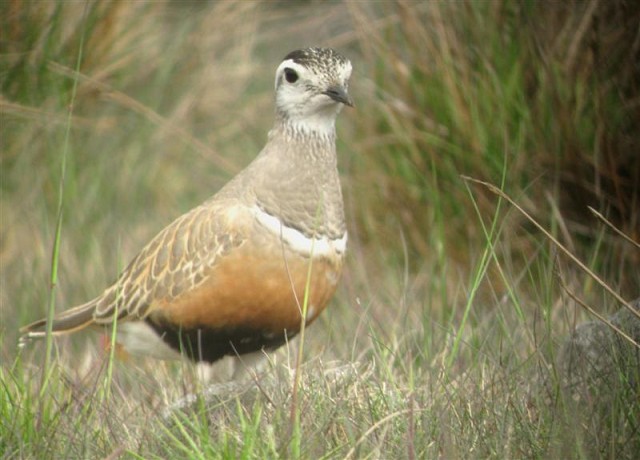
Dotterel, Pendle Hill, Lancashire (Photo: Mark Fanshawe)
With no reports of the Dorset Long-billed Dowitchers, other wader interest came in the shape of several (or one wandering) Collared Pratincoles. In Lincolnshire, a probable belatedly reported at Coningsby on 4th may have been the same bird as that at Rosper Road Pools on 6th–7th and also at Gibraltar Point on 8th. This bird didn't linger, and you wonder if it may have been the bird at Dungeness (Kent) on 10th. One of the most bizarre sights of the week was the displaying Great Snipe at Cley Marshes (Norfolk), seen for just an hour at dusk on 11th. Norfolk is by a long chalk the best county for records of this species, although the vast majority are historical records of birds shot in autumn, and this is only the third spring record for the county.
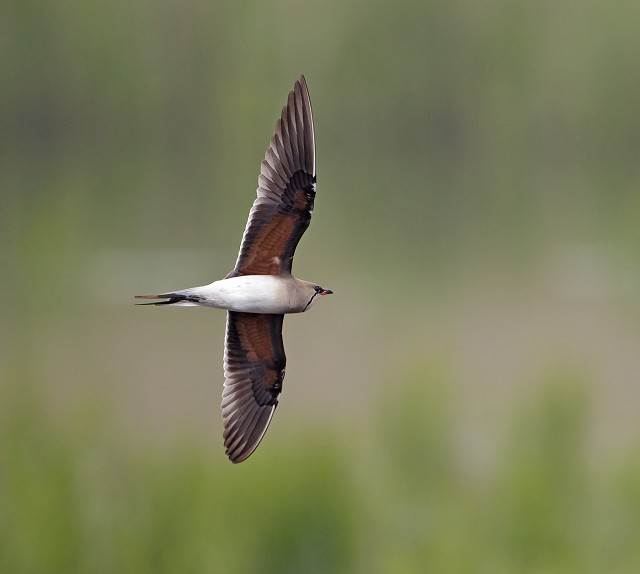
Collared Pratincole, Rosper Road Pools, Lincolnshire (Photo: Graham Catley)
Great Snipe displaying, Cley Marshes, Norfolk (video: norfolkvidiscope)
In what may have been the return of the Black-winged Stilts from April, four graced the pools at Gwithian (Cornwall) on 8th. The only other report was of a singleton at Pulias Pond (Guernsey) on 9th–10th. Also of note was a Red-necked Phalarope at Frampton Marsh (Lincs) all week.

Black-winged Stilt, Pulias Pond, Guernsey (Photo: Chris Bale)
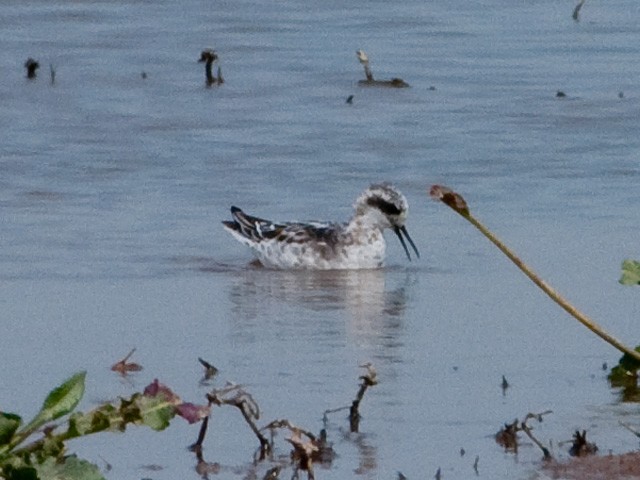
Red-necked Phalarope, Frampton Marsh RSPB, Lincolnshire (Photo: Trevor Gunby)
Glaucous Gulls were reported from five sites in England, two in Scotland and one in Ireland: a juvenile at Quilty (Clare) on 6th. Just for once, Iceland Gulls were less numerous, reported from just six sites, including three in Scotland. Quite bizarrely, Bonaparte's Gulls were almost the most numerous scarce gull, with birds remaining at eight sites. In Scotland, the first-winters remained at Borve, Lewis (Outer Hebrides) to 6th, moving to nearby Loch Stiapavat on 8th, and on the Ythan estuary (Aberdeenshire) to 10th. There was also a possible adult at Loch Ken (Dumfries & Galloway) on 10th. In the southwest, first-winters remained around Exmouth and Bowling Green Marsh (Devon) and the Hayle estuary (Cornwall) all week and, in the east, a possible first-summer went past Gorleston-on-Sea (Norfolk) on 10th.

Glaucous Gull, Seafield, Clare (Photo: Jeffcop)
In Northumberland, an adult White-winged Black Tern was at Cresswell Pond on 9th, moving to East Chevington that evening. It stayed there to 11th, also straying to Druridge Pools briefly on 10th. The only other was one south past Spurn (East Yorks) on 8th. The only other scarce tern was a Gull-billed Tern at Pulborough Brooks (West Sussex) for just three minutes on 8th, the first in the county for six years.

White-winged Black Tern, Druridge Pools, Northumberland (Photo: Chris Barlow)
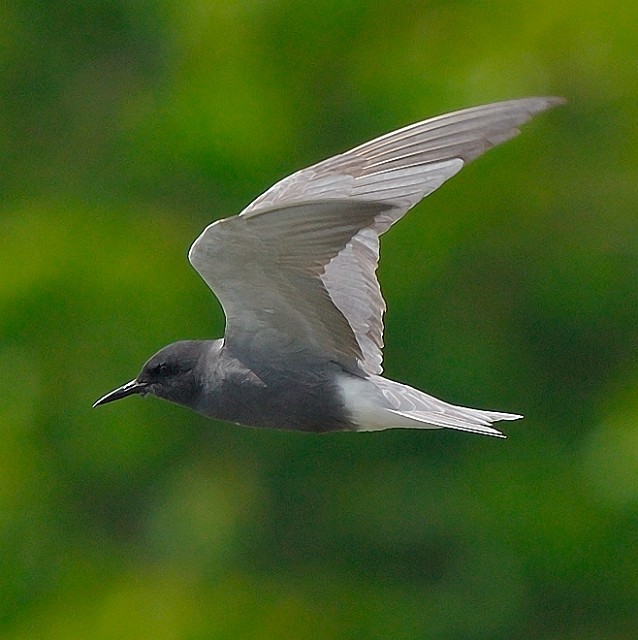
Black Tern, Belhaven Bay, Lothian (Photo: Mike Thrower)
The Snowy Owl was reported again on the Outer Hebrides, at Greinetobht, North Uist, on 11th.
The only Alpine Swift of the week was one at Ladywalk NR (Warks) on 8th, though it was gone before news was widely broadcast. Bee-eaters continued to be reported, with birds at a notable eight sites along the coast of England, and one inland at Somerton (Somerset) on 9th. In Scotland, the only record was of one over Loch Stiapavat, Lewis (Outer Hebrides) on 9th.
In shorter supply were Wrynecks, with birds in Essex, Hertfordshire, East Yorkshire and Northumberland, and two in Shetland.
The only Shore Larks now remaining were one at Landguard (Suffolk) to 5th, five at Cley Marshes (Norfolk) to 11th and two at North Gare (Cleveland) on 11th. As some sort of replacement, four more Short-toed Larks turned up: birds were at Hook Head (Wexford) on 7th–8th, Flamborough Head (East Yorks) on 8th and Newcastle (Wicklow) on 10th, but stealing the show were three together on the airfield on St Mary's (Scilly) on 11th.

Shore Lark, Cley Marshes NWT, Norfolk (Photo: Nick Appleton)
Apart from one on Papa Westray (Orkney) on 6th–7th, Hoopoes were restricted to southern sites, with single birds in Cornwall, Devon, Somerset, Gloucestershire, Buckinghamshire and Essex.
Following the report of a fly-over Tawny Pipit at Stowmarket (Suffolk) on 7th, one was then on the Isle of Noss (Shetland) on 9th–11th.
Wagtail interest for the week consisted of a probable Ashy-headed at Landguard (Suffolk) on 9th–10th and a Black-headed at Cemlyn Bay (Anglesey) on 6th, although a hint of white in the supercilium of this bird will cause some to doubt its genetic origins. The highlight, though, was yet another Norfolk Citrine Wagtail, this time a rather elusive female at Cley Marshes (Norfolk) on 7th–8th.

Blue-headed Wagtail, Bardsey Island, Gwynedd (Photo: Richard Brown)
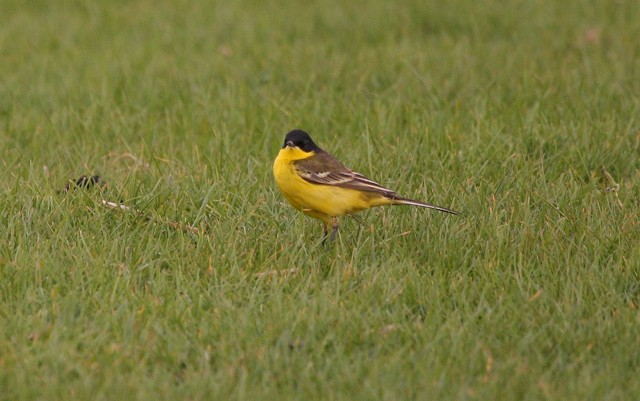
Black-headed Wagtail, Cemlyn Bay, Anglesey (Photo: Steve Culley)

Grey-headed Wagtail, Coldharbour Lagoon, Kent (Photo: Marc Heath)
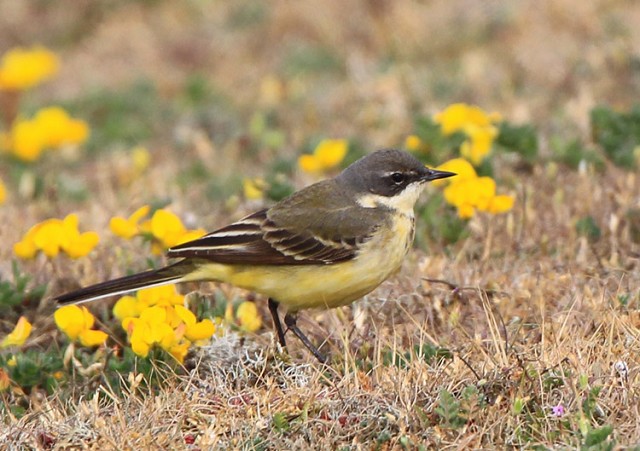
Grey-headed Wagtail, Landguard NR, Suffolk (Photo: Sean Nixon)
The white-spotted Bluethroat continued to sing at Welney (Norfolk) all week, and others were reported from North Ronaldsay (Orkney) on 8th and St Mary's (Scilly) on 10th.
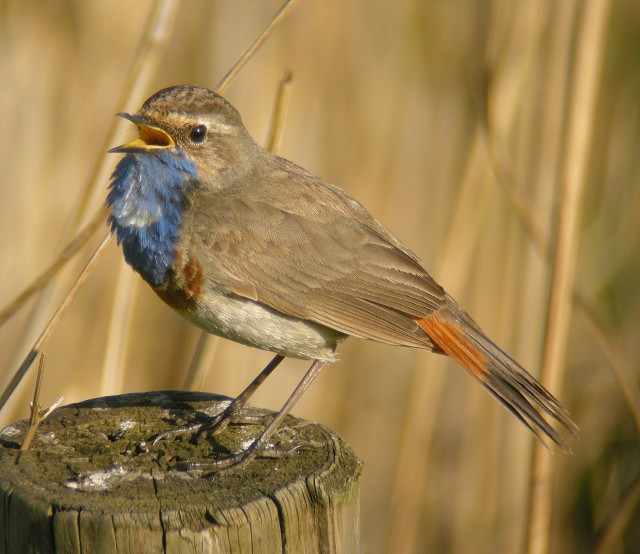
Bluethroat, Welney WWT, Norfolk (Photo: Jonathan Theobald)
This was the week for Red-rumped Swallows it seemed. Birds were at numerous sites along the south and east coasts from East Sussex to Durham, including several at Spurn (East Yorks), taking their tally for the year to an incredible 11 records! All were singletons apart from two at Dungeness (Kent) on 11th. Away from the east coast, birds were at Ballymacoda (Cork) on 8th and Leasowe (Cheshire) on 10th.

Red-rumped Swallow, Leasowe, Cheshire (Photo: Steve Round)
It seems the end might be in sight for the Waxwing invasion, with just four reports this week, three of which were singletons: at Shelley (West Yorks), Lerwick (Shetland) and Brae (Shetland). There were also 20 still at Barlborough (Derbyshire) on 6th.
The Northern Isles Bird Observatories both held Eastern Subalpine Warblers into the week, with a female on North Ronaldsay to 11th and a male on Fair Isle to 8th. Further south, Spurn (East Yorks) saw an unraced female on 5th–6th, with two more unraced birds on Shetland, at Ocraquoy and on Foula.

Subalpine Warbler, Spurn, East Yorkshire (Photo: Richard Willison)
The rush of singing Iberian Chiffchaffs slowed slightly, although perhaps they've all now settled down to produce some nice confusing hybrid offspring by now.... Birds remained in Blackpool (Lancs) to 7th and in Townley Hall Woods (Louth) to 8th, with one new bird singing at Rame (Cornwall) on 11th. The only Melodious Warbler reported was one on St Mary's (Scilly) on 9th, and other warblers of note were a Great Reed Warbler on Great Saltee (Wexford) on 7th–8th and a possible Marsh Warbler singing at Willen Lake (Bucks) on 7th. Excellent breeding news included a Firecrest carrying food at a site in Jersey, the first confirmed breeding record for the island.
Woodchat Shrikes remained on Bryher and St Martin's (Scilly), with other southern birds at Prawle Point (Dorset) and Ilston, Gower (Glamorgan). The only northern bird was at Port Nis, Lewis (Outer Hebrides) on 6th–7th, the first on the islands for almost 10 years. A couple of Red-backed Shrikes also turned up, both at Bird Observatories: one ringed at Portland (Dorset) on 7th–8th and another at Dungeness (Kent) on 9th.
After we suggested that most migrants might have passed through, there was the inevitable rush of Golden Orioles this week, with numerous records from the Isles of Scilly and west Cornwall and a scattering of birds elsewhere in the west. The only migrant in the east was one at Gibraltar Point (Lincs) on 11th. Gib's purple patch included a southbound Serin on 10th, with others over Spurn (East Yorks) on 9th and possibly the same over Humberston Fitties (Lincs) the same day.
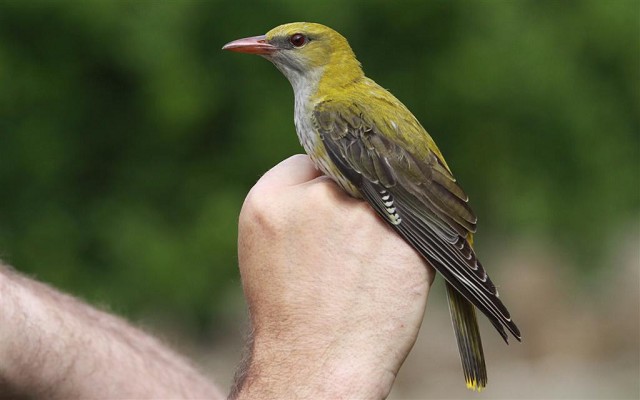
Golden Oriole, Bardsey Island, Gwynedd (Photo: Richard Brown)
Lapland Buntings also made their move this week; there were just three reports, of singletons, at Spurn on 7th, Fair Isle on 8th and Northdale, Unst (Shetland) on 9th. The only Ortolan Bunting was at the unlikely location of Richmond Park (London) on 5th.
Photo of the Week: 5th-11th May
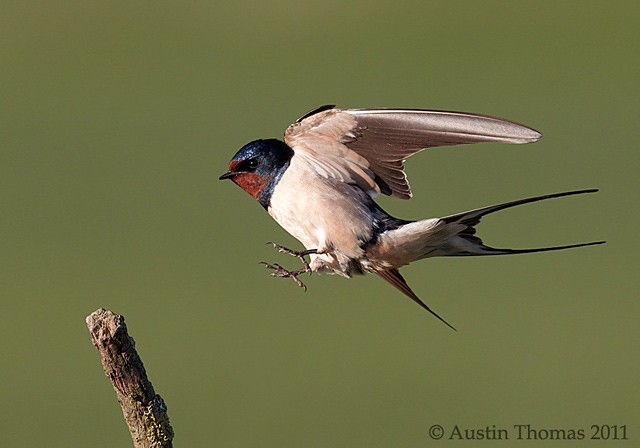
Swallow, undisclosed site, Cheshire (Photo: Austin Thomas)
BirdGuides regulars will know we're suckers for 'BIF' (birds in flight) shots, not least because of the difficulty involved. The odds are always stacked against success, and beginners can take hundreds of shots before they even get their first in-focus image, then thousands more before they get anything halfway decent. Austin Thomas is no beginner. On his blog — which has been active for nearly four years — he explains how he adopted a 'project' approach to photographing Swallows in flight, refining his technique over several sessions until he learned how to predict their behaviour. Key to his technique was timing his shots as the birds came into land (into the wind) on a favoured perch. At this point, the birds are in a predictable position and travelling at a slower speed than in normal flight. For best results, Austin caught this bird flying towards the sunlight as well as the wind, with a uniform green background to help both shapes and tones stand out. Careful composition and a dynamic pose round off a great action shot.
Other notable photos

Eider, Rathlin Island, Antrim (Photo: Ian Dickey)

Gannet, Achinhoan, Argyll (Photo: Jimmy MacDonald)

Lapwing, London Wetland Centre WWT, Greater London (Photo: Tom Hines)

Common Redstart, undisclosed site, Shropshire (Photo: John Fielding)

Wood Warbler, undisclosed site, Gwynedd (Photo: Richard Steel)

Black Grouse, undisclosed site, Highland (Photo: Marcus Conway - ebirder)

Yellow Wagtail, private site, Hertfordshire (Photo: Mike Lawrence)

Coot, Regent's Park, Greater London (Photo: Mick Colquhoun)

Long-tailed Tit, Strumpshaw Fen RSPB, Norfolk (Photo: R J Saxton)

Willow Warbler, undisclosed site, Shropshire (Photo: Karen Summers)

Dotterel, Cefn Cadlan, Glamorgan (Photo: Kev Joynes)

Sand Martin, undisclosed site, Clyde (Photo: Jim Duncan)

Grasshopper Warbler, Attenborough NR, Nottinghamshire (Photo: Jamie MacArthur)
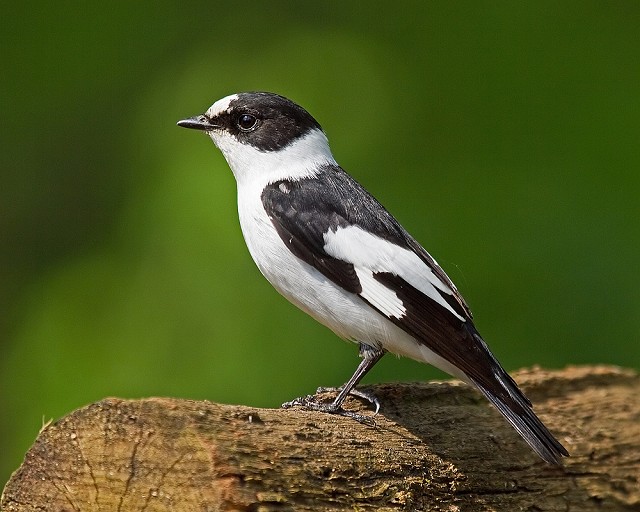
Collared Flycatcher, Hungary (Photo: Garth Peacock)

Wryneck, Qatar (Photo: Sultan)

Black-winged Stilt, Pulias Pond, Guernsey (Photo: Chris Bale)

Common Tern, Bedford, Bedfordshire (Photo: Matt Newman)

Carrion Crow, King George VI Reservoir (Permit Only), Surrey (Photo: Andrew Moon)

Reed Warbler, North Wirral CP, Cheshire (Photo: Steve Round)

Fulmar, Fife Ness, Fife (Photo: John Anderson)

